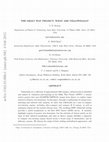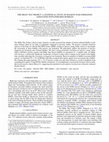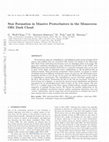Papers by Grace Wolf-Chase
We have searched the L1340 A, B, and C clouds for shocks from protostellar outflows using the H 2... more We have searched the L1340 A, B, and C clouds for shocks from protostellar outflows using the H 2 2.122 µm near-IR line as a shock tracer. Substantial out-flow activity has been found in each of the three regions of the cloud (L1340 A, L1340 B, & L1340 C). We find 42 distinct shock complexes (16 in L1340 A, 11 in L1340 B, and 15 in L1340 C). We were able to link 17 of those shock complexes in to 12 distinct outflows and identify candidate source stars for each. We examine the properties (A V , T bol , and L bol) of the source protostars and compare that to the properties of the general population of Class 0/I and flat SED protostars and find that there is an indication, albeit at low statistical significance, that the outflow driving protostars are drawn from a population with lower A V , higher L bol , and lower T bol than the general population of protostars.
The faculty of the Adler's astronomy department carries out research on a wide range of astro... more The faculty of the Adler's astronomy department carries out research on a wide range of astronomical topics in addition to their pubic outreach and educational activities. Since 2003, the Adler has partnered with the Illinois Math and Science Academy (IMSA) to involve IMSA students in this research process and to provide mentoring for students on site at the Adler. Students
Frontiers for Young Minds, 2015
Proceedings of the International Astronomical Union
We have discovered and mapped a compact (~ 80('') in extent) outflow from the gas-rich pr... more We have discovered and mapped a compact (~ 80('') in extent) outflow from the gas-rich protostar, S68N, with newly combined single-dish (Haystack) and interferometer (BIMA) data. The outflow momentum flux is ~ 4.8 x 10(-4) Msun km s(-1) yr(-1) , or about two orders of magnitude larger than the average momentum flux for Class I objects, and one order of

We present continuum-subtracted near-infrared spectral line images of a confirmed massive pre-ZAM... more We present continuum-subtracted near-infrared spectral line images of a confirmed massive pre-ZAMS object, which has not been detected at continuum wavelengths shorter than 24 microns. These images were obtained using the NIC-FPS camera on the Astrophysical Research Consortium 3.5-meter telescope at the Apache Point Observatory. We detect bipolar H2 (2.12 microns) emission within 4 arcsec of the position of the massive protostar, which is the approximate size of the core detected previously through interferometric millimeter-wave observations. We use the optical depth derived from millimeter observations, and assumptions regarding the extinction curve, to estimate the extinction at 2.12 micron and the H2 line flux. Our results have important implications for the nature of outflows from massive protostars. This research was partially funded through an Illinois Space Grant Consortium Seed Grant.

The Astrophysical Journal, 2015
Yellowballs are a collection of approximately 900 compact, infrared sources identified and named ... more Yellowballs are a collection of approximately 900 compact, infrared sources identified and named by volunteers participating in the Milky Way Project (MWP), a citizenscience project that uses GLIMPSE/MIPSGAL images from Spitzer to explore topics related to Galactic star formation. In this paper, through a combination of catalog crossmatching and infrared color analysis, we show that yellowballs are a mix of compact star-forming regions, including ultra-compact and compact H II regions, as well as analogous regions for less massive B-type stars. The resulting MWP yellowball catalog provides a useful complement to the Red MSX Source (RMS) survey. It similarly highlights regions of massive star formation, but the selection of objects purely on the basis of their infrared morphology and color in Spitzer images identifies a signature of compact star-forming regions shared across a broad range of luminosities, and by inference, masses. We discuss the origin of their striking mid-infrared appearance, and suggest that future studies of the yellowball sample will improve our understanding of how massive and intermediate-mass star-forming regions transition from compact to more extended bubble-like structures.

The faculty of the Adler's astronomy department carries out research on a wide range of astro... more The faculty of the Adler's astronomy department carries out research on a wide range of astronomical topics in addition to their pubic outreach and educational activities. Since 2003, the Adler has partnered with the Illinois Math and Science Academy (IMSA) to involve IMSA students in this research process and to provide mentoring for students on site at the Adler. Students learn the fundamentals of professional research techniques and learn how to process raw image data into scientifically useful results. To perform their research, the students learn how to use the data-reduction packages IDL and IRAF. To date, student projects have included monitoring AGN variability at visible wavelengths and studying high-mass star forming regions in the near-infrared. Students participating in this program have done exceedingly well, winning awards for their work and continuing on to major in science as undergraduates. We describe the details of this ongoing program and present samplings of...
ABSTRACT In the field of star formation, Spitzer photometry has been used to identify and classif... more ABSTRACT In the field of star formation, Spitzer photometry has been used to identify and classify young pre-main sequence stars. However, the information the data provide is not limited to studying the stellar content of these regions. Previous studies have shown that the location of shocked H2 emission in IRAC color space can be used to probe the thermal conditions of the gas. In this study we model the photometry of UV excited H2 and PAH emission in PDR regions and present the resulting color space. We show the location of this emission depends on density and external flux. We construct a diagnostic color space diagram and show examples of its utility. JY acknowledges partial support from PAPPIT-IN101813.

We propose to re-observe and enhance the original GLIMPSE survey region by following the Galactic... more We propose to re-observe and enhance the original GLIMPSE survey region by following the Galactic warp at a Galactocentric distance of 13 kpc to survey the far outer Galaxy. The new survey will cover longitudes of 15 < l l > -95, with a latitude width of 2.5 degrees; 55% of the survey will overlap with GLIMPSE, and 45% will cover new territory. The survey strategy of 3 HDR visits on each sky position will increase the dynamic range over GLIMPSE by a factor of 13 on the faint end and 3 on the bright end. The survey will be enhanced by several complementary surveys at near-IR, mid-IR, far-IR, submm, and radio wavelengths. Deep GLIMPSE will allow us to map stellar Galactic structure out to the edge of the stellar disk; map star formation and H II regions in the far outer Galaxy; improve our estimate of the star formation rate (SFR) of the Galaxy and study the SFR as a function of Galactocentric distance; study low-mass as well as high-mass star formation in the Galactic plane and...

The Astrophysical Journal, 2012
The Milky Way Project citizen science initiative recently increased the number of known infrared ... more The Milky Way Project citizen science initiative recently increased the number of known infrared bubbles in the inner Galactic plane by an order of magnitude compared to previous studies. We present a detailed statistical analysis of this data set with the Red MSX Source (RMS) catalog of massive young stellar sources to investigate the association of these bubbles with massive star formation. We particularly address the question of massive triggered star formation near infrared bubbles. We find a strong positional correlation of massive young stellar objects (MYSOs) and H ii regions with Milky Way Project bubbles at separations of <2 bubble radii. As bubble sizes increase, a statistically significant overdensity of massive young sources emerges in the region of the bubble rims, possibly indicating the occurrence of triggered star formation. Based on numbers of bubble-associated RMS sources, we find that 67% ± 3% of MYSOs and (ultra-)compact H ii regions appear to be associated with a bubble. We estimate that approximately 22% ± 2% of massive young stars may have formed as a result of feedback from expanding H ii regions. Using MYSO-bubble correlations, we serendipitously recovered the location of the recently discovered massive cluster Mercer 81, suggesting the potential of such analyses for discovery of heavily extincted distant clusters.

Monthly Notices of the Royal Astronomical Society, 2003
We present far-infrared, submillimetre, and millimetre observations of bright IRAS sources and ou... more We present far-infrared, submillimetre, and millimetre observations of bright IRAS sources and outflows that are associated with massive CS clumps in the Monoceros OB1 Dark Cloud. Individual star-forming cores are identified within each clump. We show that combining submillimetre maps, obtained with SCUBA on the JCMT, with HIRES-processed and modelled IRAS data is a powerful technique that can be used to place better limits on individual source contributions to the far-infrared flux in clustered regions. Three previously categorized "Class I objects" are shown to consist of multiple sources in different evolutionary stages. In each case, the IRAS point source dominates the flux at 12 & 25 µm. In two cases, the IRAS point source is not evident at submillimetre wavelengths. The submillimetre sources contribute significantly to the 60 & 100 µm fluxes, dominating the flux in the 100 µm waveband. Using fluxes derived from our technique, we present the spectral energy distribution and physical parameters for an intermediate-mass Class 0 object in one of the regions. Our new CO J=2→1 outflow maps of the three regions studied indicate complex morphology suggestive of multiple driving sources. We discuss the possible implications of our results for published correlations between outflow momentum deposition rates and "source" luminosities, and for using these derived properties to estimate the ratio of mass ejection rates to mass accretion rates onto protostars.
Spitzer has collected a wealth of data on star-forming regions in its first two years. Here, we p... more Spitzer has collected a wealth of data on star-forming regions in its first two years. Here, we present archival imaging results from IRAC and MIPS of a recently discovered protostellar outflow in a nearby cloud whose symmetry and appearance in the different IRAC bands make it a textbook example of a classic bipolar flow. The cavity walls are most prominent
IRAS 16253-2429 is a newly discovered Class 0 protostar in the nearby Rho Ophiuchi molecular clou... more IRAS 16253-2429 is a newly discovered Class 0 protostar in the nearby Rho Ophiuchi molecular clouds. Ground-based imaging tracing its 2.12 micron H2 emission and CO(3-2) molecular line maps reveal its bipolar, molecular outflow. The IRAC images from the Spitzer archive show a beautiful, bipolar hourglass structure, tracing the outflow cavities, in addition to shock features from the flow. The



Uploads
Papers by Grace Wolf-Chase